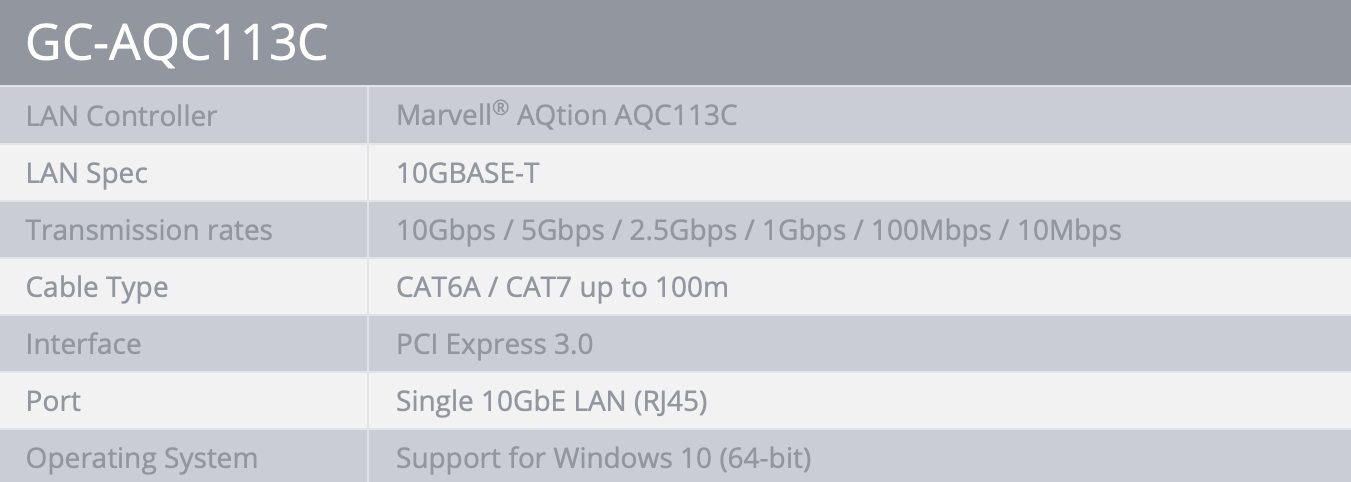Gigabyte Unveils New 10GbE NIC: Marvell AQtion AQC113C Controller

Gigabyte has introduced its new Vision-branded 10GbE network adapter that is designed specifically for creators. The card comes with a white heat spreader and is based on one of Marvell's latest 10GbE network controllers.
The Gigabyte Vision 10G LAN Card (GC-AQC113C) is a PCIe 3.0 x4 card powered by the Marvell AQtion AQC113Ccontroller and featuring an RJ45 connector that supports 100M, 1G, 2.5G, 5G and 10G speeds using Cat6a/Cat7 cabling at up to 100 meters. The board is relatively small and is equipped with a low-profile bracket, so the LAN adapter is compatible with a large range of PC form-factors.
The GC-AQC113C is not Gigabyte's first 10GbE card, but it is the company's first 10GbE adapter featuring the Marvell AQtion AQC113C controller that integrates MAC and PHY with I-grade support.
The card comes with 64-bit Windows 10 drivers and there is no word about support for Linux and other operating systems. Meanwhile Marvell supplies Linux drivers for its FastLinQ controllers.
Gigabyte has not announced pricing of the Gigabyte Vision 10G LAN Card (GC-AQC113C), though expect it to be comparable to other 10GbE adapters.
Get Tom's Hardware's best news and in-depth reviews, straight to your inbox.

Anton Shilov is a contributing writer at Tom’s Hardware. Over the past couple of decades, he has covered everything from CPUs and GPUs to supercomputers and from modern process technologies and latest fab tools to high-tech industry trends.
-
domih "...and there is no word about support for Linux..."Reply
The drivers for Aquantia-based 10GbE cards have been part of the recent upstream kernels for quite some time (2+ years?). There is nothing to install, you get 10GbE "out of the box". -
hurnii The big question: how hot do they get?Reply
As an owner of a few Aquantia based 10GE cards (and at least 2 motherboards with them, too), the largest problem with the card/chipset is heat.
Like some CNA cards, these things really needed active cooling, or at least large, hulking heat sinks and case fans moving enough air past.
Here's hoping that the new chips use a newer (smaller) process and have shaved a few watts off the power budget. -
domih Replyhurnii said:As an owner of a few Aquantia based 10GE cards (and at least 2 motherboards with them, too), the largest problem with the card/chipset is heat.
What temps do you get? On my side I have one at 59C idle.
Note: which is OK by me, I rarely use it anyway, I instead use a Mellanox ConnectX3 for 40+ GbE.
Another thing we'd like to know: the price :) Given the models from INTEL, ASUS, 10GTeck, etc at $100 up to $300++, I don't expect Gigabyte to go much lower than $100. A joke, IMHO. Still in 2021, it's cheaper to go with SFP+ *&^%$#@! In addition SFP+ is not a winter heater like RJ-45. -
Roman Shein Reply
+1. Why does it need 32Gb/s worth of lanes to deliver 10Gb /s of payload?junglist724 said:I feel weird about wasting a whole 4 lanes on a single 10Gb interface. -
domih ReplyRoman Shein said:+1. Why does it need 32Gb/s worth of lanes to deliver 10Gb /s of payload?
So that it still delivers 10GbE if plugged in a PCIe Gen 2 slot. At 5.0 GT/s 8b/10b, two lanes of PCIe Gen 2 would not be enough to tunnel 10 GbE, x3 slots do not exist, so x4. -
TJ Hooker PCIe x2 slots don't really exist, so even with PCIe gen 3 you end up needing x4 to get full bandwidth a 10 Gbps NIC.Reply -
Roman Shein Reply
Fair enough, makes sense.domih said:So that it still delivers 10GbE if plugged in a PCIe Gen 2 slot. At 5.0 GT/s 8b/10b, two lanes of PCIe Gen 2 would not be enough to tunnel 10 GbE, x3 slots do not exist, so x4. -
Roman Shein Reply
PCIE 3.0 is 8GT/s with a very small overhead ( encoding scheme to 128b/130b). x1 should be more than enough for any reasonable use case. Unless you are a sole user of a giant NAS w dozens of HDDs & huge write cache, or better an all-flash array ("as seen on Linus YT"). Anything less than that will not be able to read/write data fast enough to saturate NICs in a x3.0 slot (the limit should be around 7.5Gbps).TJ Hooker said:PCIe x2 slots don't really exist, so even with PCIe gen 3 you end up needing x4 to get full bandwidth a 10 Gbps NIC. -
Shonk. ReplyRoman Shein said:PCIE 3.0 is 8GT/s with a very small overhead ( encoding scheme to 128b/130b). x1 should be more than enough for any reasonable use case. Unless you are a sole user of a giant NAS w dozens of HDDs & huge write cache, or better an all-flash array ("as seen on Linus YT"). Anything less than that will not be able to read/write data fast enough to saturate NICs in a x3.0 slot (the limit should be around 7.5Gbps).
Umm
1GbE is 125 megabytes which is around 114 megabytes (1024 not 1000) after ethernet overheads of actual payload
10GbE is 1250 megabytes which is around 1140 megabytes (1024 not 1000) after ethernet overheads of actual payload
PCIe 3.0 x 1 is 985 megabytes which is 265 megabytes shy of being able to deliver the required bandwidth
Feel free to fit your card into an open ended 1x slot for a 7.9GbE card but dont expect a manufacturer to ship it that way
In the case of onboard devices my motherboard put it on a 2 x gen3 bus which is fine as they know its never going to be on a gen 2 bus
